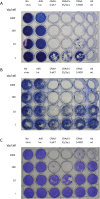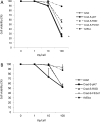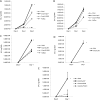A conditionally replicative adenovirus, CRAd-S-pK7, can target endometriosis with a cell-killing effect
- PMID: 20573677
- PMCID: PMC2907227
- DOI: 10.1093/humrep/deq137
A conditionally replicative adenovirus, CRAd-S-pK7, can target endometriosis with a cell-killing effect
Abstract
Background: Novel therapeutic approaches for endometriosis based on molecular strategies may prove to be useful. Conditionally replicative adenoviruses (CRAds) are designed to exploit key differences between target and normal cells. The wild-type adenovirus (Adwt) promoter can be replaced by tissue-specific promoters, allowing viral replication only in target cells. Viral infectivity can be enhanced by altering Ad tropism via fiber modification. We investigated whether CRAds can be used to target endometriosis and determined the most efficient transcriptional- and transductional-targeting strategy.
Methods: An in vitro study was carried out using human endometriotic cell lines, 11Z (epithelial) and 22B (stromal), normal human ovarian surface epithelial cell line (NOSE006) and primary human endometriosis cells. A total of 9 promoters and 12 Ad tropism modifications were screened by means of a luciferase reporter assay. From this screening data, three CRAds (CRAd-S-pK7, CRAd-S-RGD, CRAd-S-F5/3sigma1, all incorporating the survivin promoter but with different fiber modifications) were selected to perform experiments using Adwt and a replication-deficient virus as controls. CRAds were constructed using a plasmid recombination system. Viral-binding capacity, rates of entry and DNA replication were evaluated by quantitative real-time PCR of viral genome copy. Cell-killing effects were determined by crystal violet staining and a cell viability assay for different concentrations of viral particles per cell.
Results: Comparison of promoters demonstrated that the survivin promoter exhibited the highest induction in both endometriotic cell lines. Among the fiber-modified viruses, the polylysine modification (pK7) showed the best infection enhancement. CRAd-S-pK7 was validated as the optimal CRAd to target endometriosis in terms of binding ability, entry kinetics, DNA replication and cell-killing effect. CRAd-S-pK7 also exhibited a high level of DNA replication in primary endometriosis cells.
Conclusions: CRAd-S-pK7 has the best infection and cell-killing effect in the context of endometriosis. It could prove to be a useful novel method to target refractory cases of endometriosis.
Figures








Similar articles
-
Treatment of ovarian cancer with a novel dual targeted conditionally replicative adenovirus (CRAd).Gynecol Oncol. 2007 Apr;105(1):113-21. doi: 10.1016/j.ygyno.2006.10.057. Epub 2006 Dec 14. Gynecol Oncol. 2007. PMID: 17173958
-
Survivin promoter-based conditionally replicative adenoviruses target cholangiocarcinoma.Int J Oncol. 2006 Nov;29(5):1319-29. Int J Oncol. 2006. PMID: 17016667
-
Single dose GLP toxicity and biodistribution study of a conditionally replicative adenovirus vector, CRAd-S-pk7, administered by intracerebral injection to Syrian hamsters.J Transl Med. 2016 May 16;14(1):134. doi: 10.1186/s12967-016-0895-8. J Transl Med. 2016. PMID: 27184224 Free PMC article.
-
Engineering regulatory elements for conditionally-replicative adeno-viruses.Curr Gene Ther. 2003 Aug;3(4):357-85. doi: 10.2174/1566523034578311. Curr Gene Ther. 2003. PMID: 12871022 Review.
-
Virotherapeutics: conditionally replicative adenoviruses for viral oncolysis.Anticancer Drugs. 2003 Sep;14(8):577-84. doi: 10.1097/00001813-200309000-00001. Anticancer Drugs. 2003. PMID: 14501378 Review.
Cited by
-
The emerging field of viroimmunotherapy for pediatric brain tumors.Neuro Oncol. 2024 Nov 4;26(11):1981-1993. doi: 10.1093/neuonc/noae160. Neuro Oncol. 2024. PMID: 39148489 Free PMC article. Review.
-
Tamoxifen improves cytopathic effect of oncolytic adenovirus in primary glioblastoma cells mediated through autophagy.Oncotarget. 2015 Feb 28;6(6):3977-87. doi: 10.18632/oncotarget.2897. Oncotarget. 2015. PMID: 25738357 Free PMC article.
-
A vesicular stomatitis virus glycoprotein epitope-incorporated oncolytic adenovirus overcomes CAR-dependency and shows markedly enhanced cancer cell killing and suppression of tumor growth.Oncotarget. 2015 Oct 27;6(33):34875-91. doi: 10.18632/oncotarget.5332. Oncotarget. 2015. PMID: 26430798 Free PMC article.
-
Towards gene therapy of postoperative adhesions: fiber and transcriptional modifications enhance adenovirus targeting towards human adhesion cells.Gynecol Obstet Invest. 2013;76(2):119-24. doi: 10.1159/000353426. Epub 2013 Aug 6. Gynecol Obstet Invest. 2013. PMID: 23920223 Free PMC article.
-
Gene Therapy for Malignant and Benign Gynaecological Disorders: A Systematic Review of an Emerging Success Story.Cancers (Basel). 2022 Jun 30;14(13):3238. doi: 10.3390/cancers14133238. Cancers (Basel). 2022. PMID: 35805007 Free PMC article. Review.
References
-
- Adachi Y, Reynolds PN, Yamamoto M, Grizzle WE, Overturf K, Matsubara S, Muramatsu T, Curiel DT. Midkine promoter-based adenoviral vector gene delivery for pediatric solid tumors. Cancer Res. 2000;60:4305–4310. - PubMed
-
- Ambrosini G, Adida C, Altieri DC. A novel anti-apoptosis gene, survivin, expressed in cancer and lymphoma. Nat Med. 1997;3:917–921. - PubMed
-
- American Society for Reproductive Medicine. Revised American Society for Reproductive Medicine classification of endometriosis: 1996. Fertil Steril. 1997;67:817–821. - PubMed
-
- Balzar M, Winter MJ, de Boer CJ, Litvinov SV. The biology of the 17-1A antigen (Ep-CAM) J Mol Med. 1999;77:699–712. - PubMed
-
- Banu SK, Lee J, Starzinski-Powitz A, Arosh JA. Gene expression profiles and functional characterization of human immortalized endometriotic epithelial and stromal cells. Fertil Steril. 2008;90:972–987. - PubMed
Publication types
MeSH terms
Grants and funding
LinkOut - more resources
Full Text Sources
Other Literature Sources
Medical
Miscellaneous

